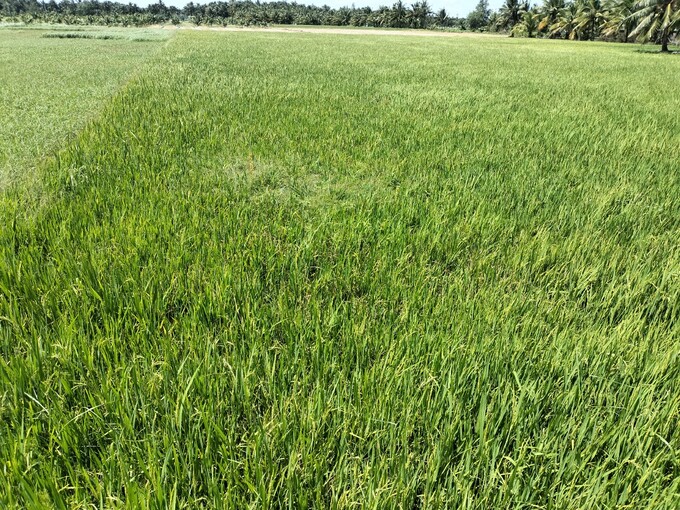
A rice field in Song Loc commune in Chau Thanh district of Tra Vinh province was bitten by rats in large numbers. Picture: Minh Dam
Some locations have 60-70% damage
Rat damage to crops is increasing in some places in Mekong Delta like Tra Vinh, Vinh Long, Can Tho city, etc. Farmers use many control measures.
In Chau Thanh district of Tra Vinh province, this year’s winter-spring harvest has very favorable weather and water sources for rice growth. Pests rarely appear, but rat damage is very common, many places suffer high damage.
Mr. Le Van Chinh, director of 9 Tao LK cooperative in Song Loc township, said that the cooperative’s relatives sown 165 ha in this crop. Currently, rats are causing damage to most of the farmers’ fields. Common damage rates are 5% or more.
According to Mr. Chinh, rat damage is not new in this crop but from previous summer-autumn, autumn-winter crops. In particular, this winter spring rice crop bites more. “The rate of rat bites and damage is 20 to 40%, sometimes even 60 to 70%. Since I was impatient, I ate as much as I could,” said Mr. Chinh.
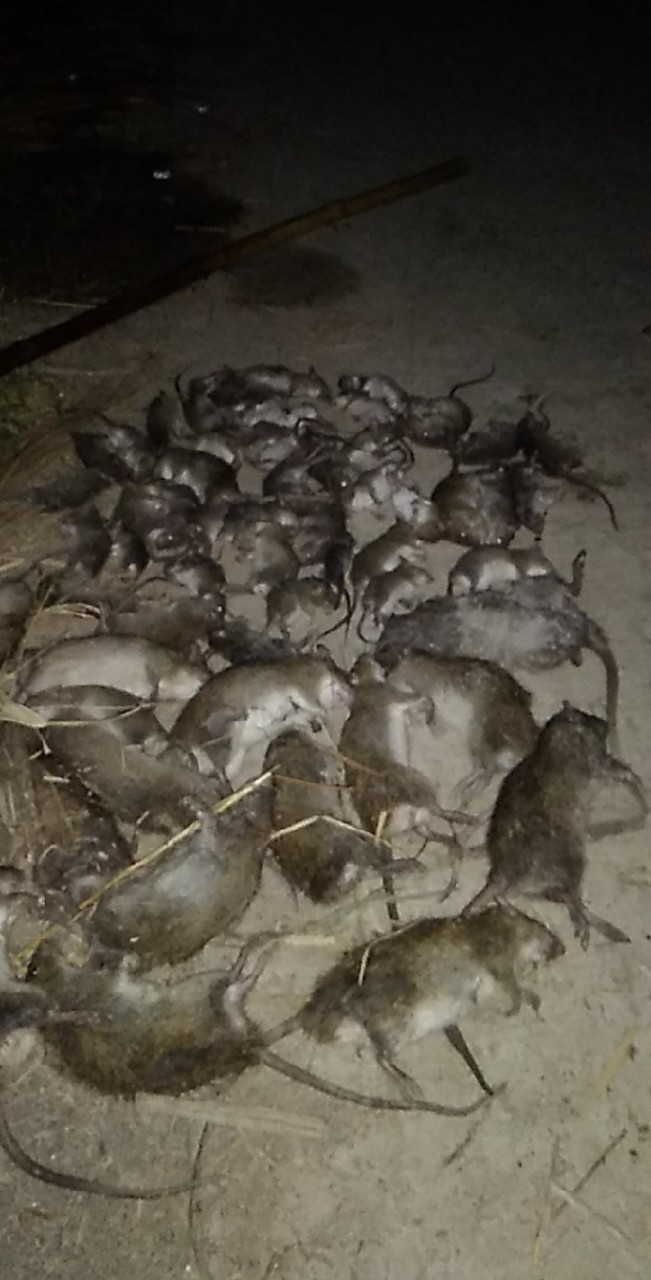
Rats caught by a member of the Phat Tai Cooperative in one night. Picture: Minh Dam.
And Mr. Tran Van Chung, director of Phat Tai Agricultural Cooperative (Thanh My Township) also confirmed: This year, rice has few pests and diseases, but too many rats. The cooperative encourages members to use many measures such as placing clamps, removing bait, spreading blankets, laying out sharp nets, etc. to kill mice at the same time.
“People unanimously set up traps and kill rats, so the percentage of rat-damaged rice is much lower than the previous crop, the damage rate is less than 10%,” Mr. Chung said.
There are many mice, so prevention costs a lot of money. Farmer Mai Van Can in Khanh Loc hamlet in Song Loc commune has 6 new paddy fields which just bloomed because rats appear frequently so he has to buy a powder every 10 days.
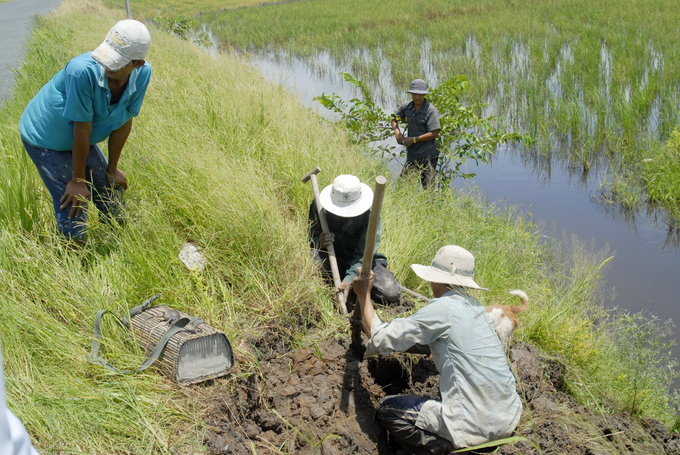
Farmers in the Mekong Delta dig up dirt to catch mice. Picture: Le Hoang Vu.
“This area is too sunny, rats cause about 10% of the damage in my field alone. The money to buy rat poison has already reached several hundreds of thousands, from now until the time of harvest there is still about a month to take the bait,” said Mr. Can.
Farmers in the province have harvested over 60,000 hectares of winter-spring rice so far, according to the Tra Vinh Ministry of Agriculture and Rural Development. Harmful rats in the province have had previous cases, and the ministry has recommended people prevent them.
Mr. Le Truong Son, director of Tra Vinh Province’s Cultivation and Plant Protection Subdepartment said: Rats appeared in this winter-spring crop, but the rate of rice damage was lower compared to the previous crop thanks to the application of many measures by farmers , Method of mass destruction and regular maintenance. In particular, it is recommended not to kill mice with electricity.
mouse racks
According to farmers and the crop protection industry in the provinces of the Mekong Delta, the rice fields bordering the orchards and grass fields have a very high rate of harmful rats.
Mr. Le Van Chan, deputy director of Dong Thap Province’s Plantation and Crop Protection Subdepartment, said rats are the object that farmers always worry about more than other harmful pests and diseases on rice. Because rats breed quickly and cause great damage to production, rats especially appear in paddy fields that do not drain floods, continuously produce 3 crops per year, or in areas where rice intercropping is planned. – Color – Orchards … These are places that “contain mice”, causing rats to quickly spread and multiply, damaging the yellow season.

A newly remodeled garden in Thanh My commune in Chau Thanh district of Tra Vinh province is home to many rats. Picture: Minh Dam.
Mr. Nguyen Vinh Phuc, director of Vinh Long Province’s Cultivation and Plant Protection Subdepartment said, The rice fields bordering the garden are often attacked by rats, with a large damage rate. In this winter-spring harvest, about 1,070 ha of winter-spring rice have been damaged by rats in Vinh Long province so far.
The rice field of 15 workers of Mr. Le Van Chinh, director of 9 Apple LK Seed Cooperative in Song Loc commune (Chau Thanh district, Tra Vinh province) was damaged by rats, causing more than 10% of the damage. Mr. Chinh said: The origin of the mouse is from the coconut garden bordering his field. Currently, people go to the garden a lot, plant grass, plant coconut trees, sugar cane … These are shelters of rats that cannot be eradicated.
In particular, since rice cultivation is not currently profitable, people are switching to orchards to grow fruit trees and grass… but not at the same time. Some people even went into the garden but left it empty because they didn’t know what to plant, resulting in overgrown grass. As a result, these freshly weeded gardens provide an ideal haven for rats to breed. Mr. Tran Van Chung, director of Phat Tai Seed Cooperative, Thanh My Township, Chau Thanh District, Tra Vinh Province, said with concern, “If a person goes to the garden, the rice farmer will die in four years, the mouse will migrate, one day passes. a whole kilometer”.
Therefore, Mr. Nguyen Vinh Phuc, Director of Plantation and Crop Protection Subdepartment of Vinh Long Province suggested: At present, the rice fields adjacent to the garden are more damaged by rats than in the fields. Therefore, going to the garden should be more concentrated, to avoid the fall of alternate leopard skin, eradication will be very difficult.
Don’t use electricity to kill mice
In order to actively prevent and minimize damage caused by rats, the Tra Vinh Plantation and Plant Protection Sub-Department has taken a series of measures to deal with rats that damage rice, under the motto “organized mass extermination of rats, kill many times and apply the same measure”.
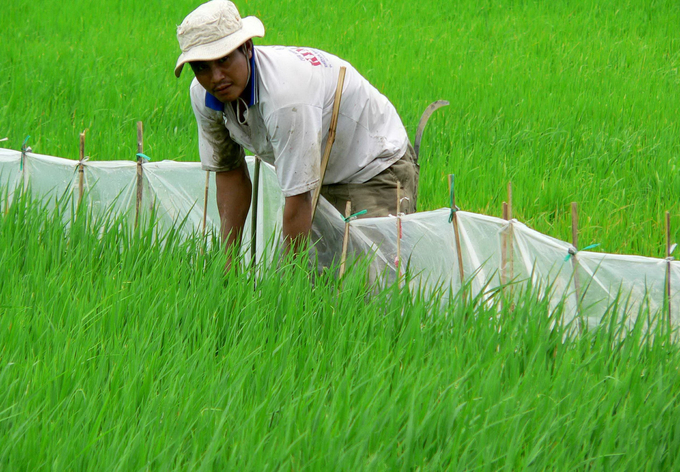
Farmers use nylon fences to protect rice from rat damage. Picture: Le Hoang Vu.
Accordingly, for agricultural measures: Farmers are recommended to clear the fields, clear the dust banks, clear the weeds along the banks, find and destroy slums at the beginning of harvest, and collect straw after harvest to cover the limit the habitat of the mice. It is necessary to determine the appropriate season, and in areas that are often severely damaged by rats, it is necessary to plant and harvest at the same time to cut off the food source, and at the same time combine with the organization of mass extermination of rats. If possible, keep the water level in the field high during the rice bloom to limit damage from rats or nests near the banks.
For physical and mechanical measures: use mechanical traps such as pinch traps, cage traps, semicircular traps, bamboo cane traps, mobile traps, etc., placed at the entrance of the cave, next to or perpendicular to the path, where there are many active rats, scatter more similar material. Only place the trap so that the bait is exposed to avoid sensitive detection of mice.
If the baited trap can be set up for a few days to allow them to get used to the trap, it is advisable to set the baited trap before sunset and collect the trap early in the morning. After catching mice, mechanical traps must be treated with boiling water or soaked in water and dried before reuse because rats are very sensitive to smell.
Look for burrows and rat nests to dig, pour water (if near a water source, earth), smoke or set fire to them, use dogs to hunt mice. Note: Do not damage irrigation systems, dikes and embankments.

Farmers use cans as bells to scare mice. Picture: Minh Dam.
Use fences around fields or catch fences. Use harvest traps in combination with barriers and cutting cages. Sow and transplant about 1,000 batches of fragrant rice varieties in each area of about 10-15ha, and plant 15-20 days earlier than bulk rice. Around the field the traps are fenced with nylon, each bank has 1-2 holes at the base of the fence to set up traps for cuttings, muzzle facing outwards.
Periodically collect mice, snakes… in cages and fix them if necessary. Rubbing agent to kill rats in some areas with conditions, scrub of branches and leaves…. as hiding places for rats at the end of the flood season. In which there is additional food for mice after 10-15 days, rub mesh bag, catch mice, scrub until mice lose weight. Never use electricity to kill mice.
Biological Measures: Encourage farmers to breed cats and dogs to kill rats. It is strictly forbidden to hunt natural enemies of rats such as pythons, snakes, owls…
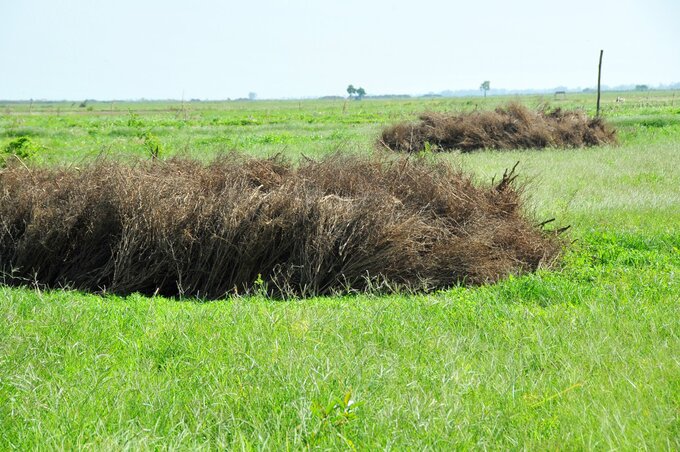
Rat trap rubbing agents. Picture: Le Hoang Vu.
Measures on the use of biological residues, rat poison: Use of residues and drugs that are on the list of pesticides authorized in Vietnam. Prioritize the use of drugs that are less toxic to humans, pets and the environment, use chemical drugs only when the rat damage is severe, and strictly adhere to safety. Read the instructions for use carefully and use them according to the “4 right” principle. Some ordinary rat poison with biological rat poison (Biorat); Group of anticoagulant drugs with the active ingredients Wafarin (Ratk 20, DP), Coumatetralyl (Racumin, Ratmiu,…), Flocoumafen (Krats, Storm…).
In Can Tho, on rice only, the area damaged by rats accounts for 2-3% annually. To help farmers protect their crops, the City People’s Committee has drawn up a Rat Prevention and Killing Plan and Roadmap to 2025 to help farmers manage their fields and gardens and minimize damage caused by rats.
According to Ms. Pham Thi Minh Hieu, Head of Can Tho’s Cultivation and Plant Protection Sub-department, Can Tho City’s Agriculture Sector will have a model plant mousetrap in 2022.
The model will be produced on an area of 1,700 m2 in the district of Thot Not. Farmers in the model of rat traps with plants guided by agricultural technicians to implement effective methods of killing rats have been very excited to help farmers here.

